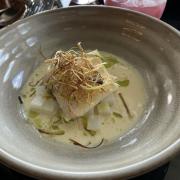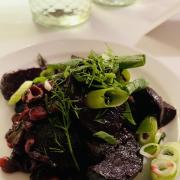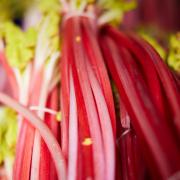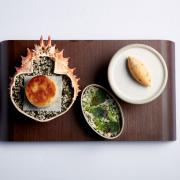Newly planted in Yorkshire, Sabrina shares the food love and a recipe for Lamb Biryani.
At long last March is here and with it comes the promise of spring, Persian New Year (which coincides with the Spring Equinox) and not forgetting, (because we'd all be in so much trouble if we did), Mother's Day. I am very fortunate to have a what I call a flexi-mum… the kind of mother who understands if I have to work or travel on Mother's Day or even, more rarely, her birthday… she is the good-natured sort that never wants a fuss and doesn't get upset if I don't get to see her on those days. To be honest, I don't think I have ever missed her birthday but we have had to delay a few Mother's Day celebrations along the way and she's always been very laid back about it.
I absolutely prefer to celebrate it on another day because, forgive the grump, the panic of trying to secure a table for lunch anywhere can be a nightmare.
So I do personally find that spoiling Mum any other day of the year means that not only am I able to get a table easily but I can do much more to spoil her as menus tend to be back to normal.
For many, Mother's Day is a family affair and if only we had a big family, I'd most definitely have everyone round at mine for lots of food and fun to spoil the lady in question.
I always joke that in my life, every single day seems to be Mother's Day (a statement she strongly refutes only to remind me that every single day is actually Daughter's Day!).
It would be fair to say that in my case, cooking a special meal is not actually that special as when Mother has a craving for Mexican, Thai, Vietnamese, French, Italian or indeed any other cuisine, Mother gets what she wishes - and I happily cook what she craves.
However there is one thing my Mother absolutely loves and that is rice, especially if it's steam-cooked the Persian way or, even better, studded with meat and steam-cooked like a good old biryani. Quite fitting as the origins of biryani hail from Persian cooks of the Royal Courts of the Mughal Empire of India.
So it is indeed a dish fit for a King (or a Queen, in this case). I have one of the simplest and most delicious recipes for a stunning lamb biryani for you to spoil your Mum, or indeed yourselves, with this month.

Lamb biryani
Serves 6-8
Biryani is a dish fit for a king and its origin is largely credited to Persia. The delicate layering of rice interspersed with spices and meat or poultry relies on a special Persian steaming method known as dam pokht (or dum pukht if you are from India), meaning 'steam-cooked'. There are now so many variation of biryani from India to Pakistan, but authentic versions have no chilli in them whatsoever - just aromatic spices such as luxurious Persian saffron. My wonderful friend Asma Khan is the Queen of Biryani and nobody has a more delicate and expert hand than she does when it comes to making the best and most authentic. Asma very kindly shared some of her biryani wisdom with me, from which I am delighted to share a simplified version of this hugely popular dish with you.
ingredients
vegetable oil
6 large onions
800g (1lb 12oz) boneless lamb neck
fillets, cut into 2.5cm (1in) chunks
1 tbsp green cardamom pods
6 black cardamom pods
4 bay leaves
2 tsp turmeric
2 tbsp cumin seeds
4 cinnamon sticks, each 7cm (3in) long
200g (7oz) Greek yogurt
sea salt
600g (1lb 5oz) basmati rice
2 generous pinches of saffron threads (optional)
2 tsp boiling water
125g (4.oz) butter
method
Preheat a large saucepan over a medium-high heat and pour in 250ml (9fl oz) vegetable oil. Chop 4 of the onions in half, then thinly slice into 5mm thick half moons. Fry the onion slices in the oil (there should b just enough oil to cover them, so add more oil if needed) stirring every few minutes, until they are golden brown and crispy. Using a slotted spoon, drain the onions on to a plate lined with kitchen paper and set aside.
Pour out the oil, leaving behind just enough to coat the base of the pan. Roughly dice the remaining 2 onion and fry them over a medium-high heat until they becom translucent. Add the diced lamb and sear it until it begins to brown. Put in the green and black cardamom pods, bay leaves, turmeric, cumin seeds and cinnamon sticks and mix well. Pour in just enough boiling water to barely cover the meat, reduce the heat to medium and cook the lamb for about an hour until just tender. Leave to cool. Once cooled, add the yogurt to the lamb, season generously with sea salt, stir well and set aside.
Preheat a large saucepan over a medium-high heat.
Fill the pan with boiling water and add the rice with a generous handful of crumbled sea salt. Boil for 6-8 minutes until the rice is parboiled. You will know it is parboiled when the colour of the grains turns from the normal dullish white to a more brilliant white and the grains become slightly elongated and begin to soften.
Drain the rice and rinse it immediately under cold running water for a couple of minutes to wash off all the excess starch until it is cool.
Line the bottom of the saucepan used to parboil the rice with some nonstick baking paper and set aside.
Grind the saffron (if using) with a pestle and mortar, then pour over the 2 tablespoons of boiling water and leave to infuse.
Back to the rice; return the paper-lined saucepan to the hob and pour in a generous drizzle of oil with a couple of good knobs of the butter. Add 1 tablespoon crushed sea salt.
Scatter in just enough rice to cover the base of the pan with a good layer. Drizzle a little of the saffron water (if using) over this layer of rice.
Take the yogurt-marinated pre-cooked lamb and divide it into two portions. Layer one portion over the rice, then cover with a thin layer of rice, sprinkle over some more saffron water (if using), then add a generous layer of crispy onions and dot more butter on top. Repeat the layers until the rice, lamb, crispy onions and butter are all used up.
Wrap the pan lid in a tea towel, cover the pan and cook the rice on the lowest temperature possible if using gas, or low-medium heat if using electric, for 30-45 minutes, or until the rice is cooked. When ready to serve, either flip the rice on to a serving dish or decant on to a serving platter, then scrape out the crispy rice from the base of the pan and serve it on top of the rice.





























